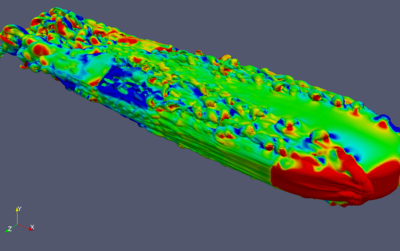Turbulence Modeling: Boundary Layers and Scale Transitioning

Thanks to numerous technical studies the physical law of periodic flow instability in fluid flows with high Reynolds numbers is well-known. The laminar character (stream lines positioned in laminar layers) is destroyed by perturbations, which diffuse from the wall through the complete flow domain. The change from a steady laminar stream to an unsteady turbulent flow is defined as transient.
The transient behavior in turbulent flows is investigated by modeling the velocity correlations in the fluid. Statistical models are used to describe the turbulent momentum and energy diffusion inside the fluid flow. Turbulence models based on this method are called eddy-diffusivity models. The velocity correlations are modeled by an increased viscosity diffusion term. Alternative models are based on transport equations for the Reynold-averaged velocity-correlation tensor (RANS), an approach called Reynolds-averaged Navier-Stokes simulation. The models mentioned above describe the unsteady behavior through averaged steady state transport equations. Current methods use unsteady transport equations describing the diffusion and convection of large vortices (eddies). This approach, which resolves small time and length scales, is used for the description of fluid/wall interactions, for averaging physical properties and in order to resolve shear stresses at the wall.
Both the convection and the diffusion processes of mass, momentum and energy inside the computational domain must be described by discrete fluxes between the cell volumes. As a result, the influence of not directly calculated fluxes has to be described by so-called sub-grid scale-models (SGS), whose development represents the main research topic in computational modeling.


 "
"